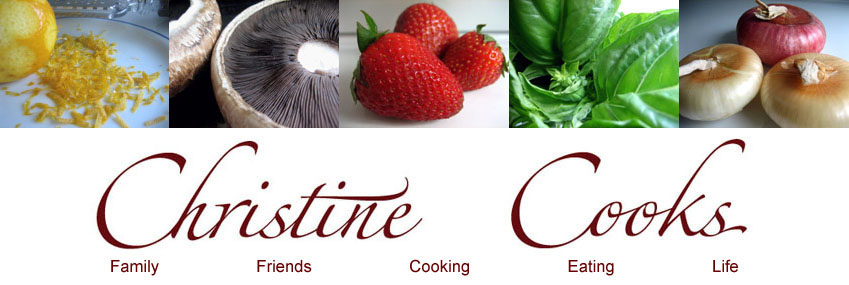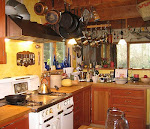[Ed. note: Way back in 2008, I sent this post to my friend Paz at The Cooking Adventures of Chef Paz and neglected to put it on my own blog. I've decided to remedy that. This update will not have some of the same wording as the original post, but the method and recipe are the same.]
When I posted my Sunday Night Whole Roasted Chicken recipe a while back, Paz fairly sang its praises from the rooftops of New York and re-posted it on her blog, creating quite a bit of traffic my way. That's just the way she is, thoughtful and generous. And because Paz was so excited about my roasted chicken, I thought it would be fun to show her another method that I think she will find entertaining and make her giggle: Spatchcocking.
Now before your minds head to the gutter, spatchcocking (and, please do visit that link for some very funny, veddy British definitions) is simply a method by which a chicken or other fowl is opened and spread flat, enabling it to cook faster and more evenly. To achieve this, you remove the backbone of the bird, lay it out flat, breast side up, and crack the breast bone to flatten it out.
That's it. Rub it all over with olive oil then sprinkle with your favorite herbs, kosher salt and freshly ground black pepper. Put it in a cast iron skillet with a glug or two of wine (red or white, it's your choice) and roast it to perfection. Easy, simple and delicious. If you like giblets, tuck them in and around the bird so they roast together. Oh, and don't forget to baste your bird with those tasty pan juices that will magically appear at the bottom of the skillet.
To spatchcock a chicken:
To spatchcock a chicken:
Put a whole chicken, breast side down, on a cutting board.
Using poultry shears or other strong kitchen shears, begin cutting up one side of the backbone beginning at the tail end. You may have to use a bit of pressure to cut through some of the bones, especially when you get to the bones that connect the wings to the body.
When one side is fully cut, do the same thing on the other side of the backbone, starting again from the tail end.
When the backbone is completely severed from the chicken, set it aside and inspect the chicken where you made the cuts. Remove any small bones laying about that could come loose in the cooking process and get stuck in a guest's teeth or, worse, in his/her throat.
Small bone inspection done, turn your chicken over and spread it out on the cutting board as shown in the photo.
Using your hand, push hard on the breast bone until it cracks or gives to the point that the chicken lies very flat on the board.
Using poultry shears or other strong kitchen shears, begin cutting up one side of the backbone beginning at the tail end. You may have to use a bit of pressure to cut through some of the bones, especially when you get to the bones that connect the wings to the body.
When one side is fully cut, do the same thing on the other side of the backbone, starting again from the tail end.
When the backbone is completely severed from the chicken, set it aside and inspect the chicken where you made the cuts. Remove any small bones laying about that could come loose in the cooking process and get stuck in a guest's teeth or, worse, in his/her throat.
Small bone inspection done, turn your chicken over and spread it out on the cutting board as shown in the photo.
Using your hand, push hard on the breast bone until it cracks or gives to the point that the chicken lies very flat on the board.
There. You're done. You've just spatchcocked a chicken. Now, cook it...
Christine's Spatchcocked Pan-Roasted Chicken
print recipe
Serves 4-6 chicken-loving people or 6-8 daintier eaters
Ingredients:
1 (4-5 pound) broiler or fryer chicken preferrably with giblets, preferrably free-range
Good olive oil
2 tablespoons (or more) dried herbs - I used Made in Napa Valley's Meritage Rub, which I highly recommend
Kosher salt
Freshly ground black pepper
olive oil spray for the pan
1/4 cup (a few glugs) of your favorite red or white wine
Ingredients:
1 (4-5 pound) broiler or fryer chicken preferrably with giblets, preferrably free-range
Good olive oil
2 tablespoons (or more) dried herbs - I used Made in Napa Valley's Meritage Rub, which I highly recommend
Kosher salt
Freshly ground black pepper
olive oil spray for the pan
1/4 cup (a few glugs) of your favorite red or white wine
Preparation:
Rub the bird all over with good olive oil. Do the same with the giblets and the backbone if you are using them (see Cook's Notes.)
Sprinkle the herb rub, salt and pepper all over both sides of the bird, pressing into the skin to help them adhere.
Lightly spray a large cast iron skillet (I used a 12-inch one, old Wagner Ware, without which I would be one unhappy cook) with the olive oil.
Place the chicken breast side up in the skillet, arranging the legs and wings so it all fits snugly. The underside (inside) of the chicken should be flat in the skillet.
Tuck the giblets around and under the wings and neck area and lay the backbone under the legs as shown in the photo.
Pour the wine over the bird, cover the skillet with foil and place in a 375-degree oven for 45 minutes.
At the 45-minute mark, remove the foil from the skillet and baste your bird, giblets and all, with the pan juices.
Close the oven and roast for 15 more minutes, basting once again during that time.
Stick an instant-read temperature guage in the meatiest part of the thigh; a nicely done chicken should register 160 degrees farenheit and the juices from the joints should run clear.
Remove the skillet from the oven and baste the chicken one more time before transferring it to a cutting board where you will let it rest for 10 minutes. Remove the giblets to a plate.
Pour the pan drippings into a fat separator and decant into a warm serving bowl or pitcher.
To cut into serving pieces, using kitchen or poultry shears, divide the bird into two halves, each having a half breast, a wing and a leg-thigh. Separate the entire leg-thigh piece and finally cut the breast pieces into two equal halves, cross-wise, leaving the wing attached to one of the pieces. This will give you three pieces from each side, which will nicely feed six hungry people. For daintier eaters, separate the thigh from the leg, thus being able to share your dish with 8 guests.
Sprinkle the herb rub, salt and pepper all over both sides of the bird, pressing into the skin to help them adhere.
Lightly spray a large cast iron skillet (I used a 12-inch one, old Wagner Ware, without which I would be one unhappy cook) with the olive oil.
Place the chicken breast side up in the skillet, arranging the legs and wings so it all fits snugly. The underside (inside) of the chicken should be flat in the skillet.
Tuck the giblets around and under the wings and neck area and lay the backbone under the legs as shown in the photo.
Pour the wine over the bird, cover the skillet with foil and place in a 375-degree oven for 45 minutes.
At the 45-minute mark, remove the foil from the skillet and baste your bird, giblets and all, with the pan juices.
Close the oven and roast for 15 more minutes, basting once again during that time.
Stick an instant-read temperature guage in the meatiest part of the thigh; a nicely done chicken should register 160 degrees farenheit and the juices from the joints should run clear.
Remove the skillet from the oven and baste the chicken one more time before transferring it to a cutting board where you will let it rest for 10 minutes. Remove the giblets to a plate.
Pour the pan drippings into a fat separator and decant into a warm serving bowl or pitcher.
To cut into serving pieces, using kitchen or poultry shears, divide the bird into two halves, each having a half breast, a wing and a leg-thigh. Separate the entire leg-thigh piece and finally cut the breast pieces into two equal halves, cross-wise, leaving the wing attached to one of the pieces. This will give you three pieces from each side, which will nicely feed six hungry people. For daintier eaters, separate the thigh from the leg, thus being able to share your dish with 8 guests.

Cook's Notes:
I love giblets and I love the tasty morsels of meat on the backbone of a chicken, especially the tiny tenderloins. If you can find them, see if you don't agree with me.
The corn photo? Sometimes a food photo is so delectable, it must be shared.



















